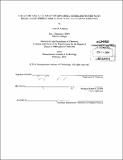| dc.contributor.advisor | Robert G. Griffin. | en_US |
| dc.contributor.author | Andreas, Loren B | en_US |
| dc.contributor.other | Massachusetts Institute of Technology. Department of Chemistry. | en_US |
| dc.date.accessioned | 2014-05-23T19:34:21Z | |
| dc.date.available | 2014-05-23T19:34:21Z | |
| dc.date.copyright | 2014 | en_US |
| dc.date.issued | 2014 | en_US |
| dc.identifier.uri | http://hdl.handle.net/1721.1/87466 | |
| dc.description | Thesis: Ph. D., Massachusetts Institute of Technology, Department of Chemistry, 2014. | en_US |
| dc.description | Cataloged from PDF version of thesis. Vita. | en_US |
| dc.description | Includes bibliographical references. | en_US |
| dc.description.abstract | Determination of the 3D structure of membrane proteins is a frontier that is rapidly being explored due to the importance of membrane proteins in regulating cellular processes and because they are the target of many drugs. In addition, measuring and understanding how these proteins interact with ligands and other molecules is of critical importance to the design of the next generation of therapeutic agents. With this motivation, we report new methods for the structural characterization of proteins using magic angle spinning (MAS) nuclear magnetic resonance (NMR) applied to the membrane protein M2 from Influenza A, a small helical transmembrane proton transporter that is the target of adamantane based inhibitors but which is now drug resistant due primarily to the point mutation S31N. The development of techniques that boost the sensitivity of NMR are key to its extension to larger molecules such as membrane proteins, and two such methods, dynamic nuclear polarization (DNP) and proton detection, are applied herein. We report the measurement of the distance between the amine of the inhibitor rimantadine and the pore of M2 using DNP. We have applied recoupling techniques to assign the spectra and measure internuclear distances in the drug resistant S31N mutant of M2 in lipid bilayers. Attenuation of strong proton dipole couplings with 60 kHz spinning has allowed us to detect well-resolved proton spectra, and with the higher receptivity of protons, we measured interhelical distances with a methyl-methyl 4D spectrum. Synthesis of the information resulted in a high resolution structure of S3 IN M2. | en_US |
| dc.description.statementofresponsibility | by Loren B. Andreas. | en_US |
| dc.format.extent | 245 pages | en_US |
| dc.language.iso | eng | en_US |
| dc.publisher | Massachusetts Institute of Technology | en_US |
| dc.rights | M.I.T. theses are protected by copyright. They may be viewed from this source for any purpose, but reproduction or distribution in any format is prohibited without written permission. See provided URL for inquiries about permission. | en_US |
| dc.rights.uri | http://dspace.mit.edu/handle/1721.1/7582 | en_US |
| dc.subject | Chemistry. | en_US |
| dc.title | Structure and function of the Influenza membrane protein M2 by magic angle spinning NMR and dynamic nuclear polarization | en_US |
| dc.type | Thesis | en_US |
| dc.description.degree | Ph. D. | en_US |
| dc.contributor.department | Massachusetts Institute of Technology. Department of Chemistry | |
| dc.identifier.oclc | 879662023 | en_US |
